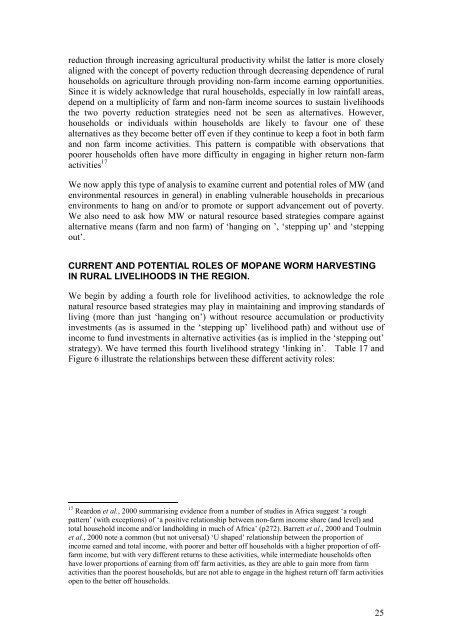Mopane worm utilisation and rural livelihoods in Southern Africa
Mopane worm utilisation and rural livelihoods in Southern Africa
Mopane worm utilisation and rural livelihoods in Southern Africa
You also want an ePaper? Increase the reach of your titles
YUMPU automatically turns print PDFs into web optimized ePapers that Google loves.
eduction through <strong>in</strong>creas<strong>in</strong>g agricultural productivity whilst the latter is more closely<br />
aligned with the concept of poverty reduction through decreas<strong>in</strong>g dependence of <strong>rural</strong><br />
households on agriculture through provid<strong>in</strong>g non-farm <strong>in</strong>come earn<strong>in</strong>g opportunities.<br />
S<strong>in</strong>ce it is widely acknowledge that <strong>rural</strong> households, especially <strong>in</strong> low ra<strong>in</strong>fall areas,<br />
depend on a multiplicity of farm <strong>and</strong> non-farm <strong>in</strong>come sources to susta<strong>in</strong> <strong>livelihoods</strong><br />
the two poverty reduction strategies need not be seen as alternatives. However,<br />
households or <strong>in</strong>dividuals with<strong>in</strong> households are likely to favour one of these<br />
alternatives as they become better off even if they cont<strong>in</strong>ue to keep a foot <strong>in</strong> both farm<br />
<strong>and</strong> non farm <strong>in</strong>come activities. This pattern is compatible with observations that<br />
poorer households often have more difficulty <strong>in</strong> engag<strong>in</strong>g <strong>in</strong> higher return non-farm<br />
activities 17<br />
We now apply this type of analysis to exam<strong>in</strong>e current <strong>and</strong> potential roles of MW (<strong>and</strong><br />
environmental resources <strong>in</strong> general) <strong>in</strong> enabl<strong>in</strong>g vulnerable households <strong>in</strong> precarious<br />
environments to hang on <strong>and</strong>/or to promote or support advancement out of poverty.<br />
We also need to ask how MW or natural resource based strategies compare aga<strong>in</strong>st<br />
alternative means (farm <strong>and</strong> non farm) of ‘hang<strong>in</strong>g on ’, ‘stepp<strong>in</strong>g up’ <strong>and</strong> ‘stepp<strong>in</strong>g<br />
out’.<br />
CURRENT AND POTENTIAL ROLES OF MOPANE WORM HARVESTING<br />
IN RURAL LIVELIHOODS IN THE REGION.<br />
We beg<strong>in</strong> by add<strong>in</strong>g a fourth role for livelihood activities, to acknowledge the role<br />
natural resource based strategies may play <strong>in</strong> ma<strong>in</strong>ta<strong>in</strong><strong>in</strong>g <strong>and</strong> improv<strong>in</strong>g st<strong>and</strong>ards of<br />
liv<strong>in</strong>g (more than just ‘hang<strong>in</strong>g on’) without resource accumulation or productivity<br />
<strong>in</strong>vestments (as is assumed <strong>in</strong> the ‘stepp<strong>in</strong>g up’ livelihood path) <strong>and</strong> without use of<br />
<strong>in</strong>come to fund <strong>in</strong>vestments <strong>in</strong> alternative activities (as is implied <strong>in</strong> the ‘stepp<strong>in</strong>g out’<br />
strategy). We have termed this fourth livelihood strategy ‘l<strong>in</strong>k<strong>in</strong>g <strong>in</strong>’. Table 17 <strong>and</strong><br />
Figure 6 illustrate the relationships between these different activity roles:<br />
17 Reardon et al., 2000 summaris<strong>in</strong>g evidence from a number of studies <strong>in</strong> <strong>Africa</strong> suggest ‘a rough<br />
pattern’ (with exceptions) of ‘a positive relationship between non-farm <strong>in</strong>come share (<strong>and</strong> level) <strong>and</strong><br />
total household <strong>in</strong>come <strong>and</strong>/or l<strong>and</strong>hold<strong>in</strong>g <strong>in</strong> much of <strong>Africa</strong>’ (p272). Barrett et al., 2000 <strong>and</strong> Toulm<strong>in</strong><br />
et al., 2000 note a common (but not universal) ‘U shaped’ relationship between the proportion of<br />
<strong>in</strong>come earned <strong>and</strong> total <strong>in</strong>come, with poorer <strong>and</strong> better off households with a higher proportion of offfarm<br />
<strong>in</strong>come, but with very different returns to these activities, while <strong>in</strong>termediate households often<br />
have lower proportions of earn<strong>in</strong>g from off farm activities, as they are able to ga<strong>in</strong> more from farm<br />
activities than the poorest households, but are not able to engage <strong>in</strong> the highest return off farm activities<br />
open to the better off households.<br />
25

















